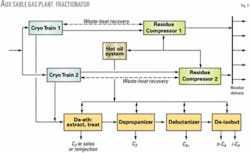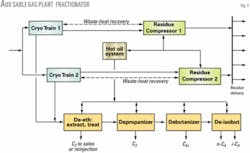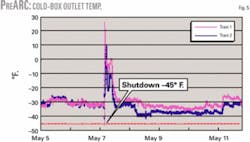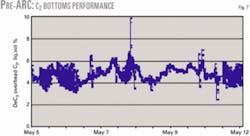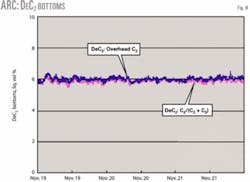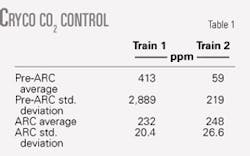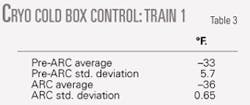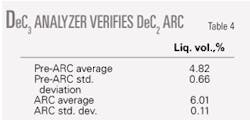Implementation of advanced regulatory control (ARC) proved effective for enhancing cryogenic plant and fractionation plant control at the Aux Sable Liquid Products Inc. dual-train cryogenic NGL recovery and separation plant near Channahon, Ill.
The project focused on advanced control strategies for two identical parallel cryogenic trains for the facility and the single-train NGL fractionation unit, which processes the recovered NGLs from the cryogenic units.
Each cryogenic train incorporates Ortloff’s Recycle Split Vapor (RSV) and Gas Sub-cooled Process (GSP) processes. For the RSV process, an additional reflux stream is introduced into the demethanizer. These processes allow operating flexibility of the extraction facility over a wide range of ethane recoveries, nominally from 20% to 95%.
The control strategies are designed for smoother operation of cryogenic trains with reduced upsets caused by inlet-btu changes, loss of RSV flow, or other conditions. These strategies also help the plant operate the two trains either in pressure-control mode or rate-control mode.
Implementing these strategies achieves the following:
- Minimization of production losses from a shutdown of a cryogenic train due to an upset in RSV flow.
- On-spec NGL product maintenance and enhanced NGL recoveries by operating at higher CO2 content in the demethanizer bottoms.
- Less variation in demethanizer bottoms flows, which will help the fractionator train run more smoothly.
- Reduced residue-compression horsepower and more stable residue control by maintaining a minimum differential pressure across each of a maximum of five residue-delivery control valves that may be in service at any one time.
Each train can operate in pressure-control mode or in rate-control mode, with the other train automatically assigned to the opposite mode. This allows the plant to meet nominations by automatically regulating the residue-compressor speed and the demethanizer pressure subject to several important constraints.
Plant
The Aux Sable NGL recovery plant at Channahon currently processes 1.3-1.8 bcfd (Fig. 1). It employs two parallel cryogenic turboexpander units, each with dedicated molecular-sieve gas dehydration and NGL extraction with an expander-compressor system. Each unit is designed to process up to 1.05 bcfd with 15,000 hp of recovered boost.
The fractionation train includes an ethane-recovery unit with a single de-ethanizer and includes ethane treatment, dehydration, liquefaction, and delivery to a 1,440-psi pipeline. The C3+ fractionation unit consists of a single train to fractionate propane and heavier liquids and produces treated products of propane, iso-butane, normal butane, and pentane plus.
Control system
The plant, constructed in 1999-2000, employs a modern distributed control system (DCS) plus an online analyzer system with a modbus communication interface to the DCS. The DCS is equipped with a powerful process historian utilizing a relational database system. The analyzer and historian systems were essential to the effective execution of the project and the assessment of results. All advanced regulatory control algorithms are executed on the existing DCS, and no additional control equipment or software was required for the project.
Philosophy
Advanced regulatory control (ARC) strategies have delivered operational and economic benefits in cryogenic NGL extraction and fractionation (OGJ, Sept. 23, 2002, p. 74; May 19, 2003, p. 56). ARC strategies reduce variation in NGL extraction performance and in fractionation-tower product qualities. This facilitates economic operating objectives and honors operational constraints and product specifications.
In the turboexpander process, manipulation of expander vanes and recompressor speeds with constraints permits smooth operation and rapid response to upsets and equipment trips, adjusting cryogenic processing rates to maintain residue deliveries within allowable limits.
An advanced composition controller manages demethanizer bottoms composition key at low levels of CO2 (200-300 ppm) in the face of significant variation in inlet composition and rates. An enhanced reflux-management strategy prevents loss of a train due to cold box low temperature shutdown during an interruption of the RSV flow.
A project methodology was followed to ensure that the implemented solution is comprehensive and meets objectives.
The objectives of the ARC NGL recovery and distillation strategies are to enhance NGL recovery, reduce excess compression horsepower, and minimize the variation in product qualities (compositions), and improve yield of higher valued products. This requires the use of feed-forward controls and strategies that minimize control interaction. The NGL-recovery section was upgraded with dual composition controllers.
Because changes to the material-balance split significantly affect product compositions and separation capability directly affects tower loading, this control loop pairing is observed:
- The material-balance split is used to control the more-valued product quality.
- The separation capability is used to control the less-valued product quality.
This ARC arrangement facilitates highly effective optimization strategies using set point management.
Project methodology is as follows:
- Establish the scope of the control design.
- Identify disturbances.
- Identify tower operational constraints.
- Identify constraints to production maximization.
- Identify operational objectives.
- Design to facilitate optimization.
Results
In preparation for the implementation of advanced regulatory control at the Aux Sable plant, the basic regulatory controllers were re-tuned. This re-tuning brought about some improvement in operations. All improvements noted here result from both re-tuning basic controllers and adding ARC.
CO2 control
For the cryogenic plant, maintaining the NGL on specification in the demethanizer-bottom product was a major concern for the operators. Using open-loop control, they manipulated the reboiler’s outlet temperature set point to control the CO2 composition.
The CO2 limit in the liquid in the bottom of the demethanizer is roughly 500 ppm that equates to a 1,200-ppm specification on the ethane product. Before implementation of ARC, the operators manually tried to balance between maximizing ethane recovery and maintaining the CO2 specification.
Fig. 2 shows the CO2 control for the two trains before ARC was implemented. Even 5-btu changes in the inlet-gas composition cause significant CO2 problems. The difficulty of control seen in Fig. 2 shows why the operators frequently operated with 0 ppm CO2 in the bottom of the demethanizers.
Operating with the CO2 at 200 ppm or less requires operating with the demethanizer bottom’s temperature higher than would be required to maintain the CO2 at the design specification of 1,200 ppm. This higher temperature reduces ethane recovery in the demethanizers.
From Aux Sable board operator experience, the demethanizers’ Bed No. 3 temperatures were good indicators if the tower was “too hot” and losing ethane recovery, or if the tower was “too cold,” which would lead to a CO2 excursion.
When the operators saw these changes taking place, they manually adjusted the output of the reboiler’s outlet temperature controller set point. These manual adjustments normally upset the demethanizer and required a lengthy recovery period.
After ARC implementation for the CO2 control, operators do not have to worry about CO2 excursions. The composition control of both demethanizers is now closed loop. The CO2 controller controls the Bed 3 temperature set point, rather than the reboiler’s temperature set point and has a feed-forward term that compensates for inlet-btu changes. Bed 3’s temperature response to CO2 in the bottoms changes well before the reboiler’s outlet temperature. The CO2 in the bottoms product is currently controlled at 200 ppm with a standard deviation of 30 ppm. Operator intervention is no longer required when inlet btus change.
Fig. 3 shows the demethanizer CO2 control, which is much improved over the pre-ARC results.
Residue-header pressure control
The Aux Sable plant has two trains in parallel and of equal capacities. Because these two trains share the same inlet gas and discharge into the same residue-gas header, managing the load between the two trains is important. Not managing and tuning the two trains properly can result in their working against each other. This will not only cause the cryogenic section to swing but will also result in disturbance of the fractionation train.
Nomination from gas control determined residue pressures for both Aux Sable turboexpander plants. This nomination was revised every 6 hr. The residue line pressure is elevated at night to pack the line for the following day’s demand. To achieve the desired nominated pressure, the operator manually changed the speed of the residue compressors. In addition, a plant upset can affect the residue pressure, forcing the operator to take manual action on the residue-compressor’s speed.
It was found that the Honeywell DCS system was capable of remotely controlling the speed set point of the residue compressors. Previously, automatic residue-pressure control had been attempted with unsatisfactory results.
ARC control of the plant’s processing rate provided the ability to regulate and manage residue pressures automatically. Both gas trains were configured for the gas throughput to be on flow control or header pressure control. They were configured so that when they are in ARC they cannot both be on flow control or pressure control.
The ARC strategy manipulates both the compressor speed’s set point and the demethanizer tower’s pressure set point to maintain the designated header pressure or throughput. High and low limits for the demethanizer pressure’s set points and for the residue compressor’s speed are displayed on the graphic and can be changed directly from the graphic by the operator. The graphic displays whether the train is in pressure or flow control and the train can be switched “bumplessly” from one mode to the other.
If the compressor is running against the high limit and the operator lowers the high limit, the header pressure control will automatically increase the demethanizer’s pressure to maintain control.
This plant supplies gas to several customers spaced several miles apart. One of the jobs of the operators is to maintain the residue header’s pressure high enough to supply all the customers with their nominated flows. The pressure change (ΔP) across each customer’s inlet valve is supplied to the operator. If the lowest ΔP is high, then compressor horsepower is being wasted. To reduce this waste, a ΔP controller was added to optimize the residue header’s pressure controller scheme.
Operators have the option of setting a minimum ΔP set point and letting the ARC automatically maintain the header pressure to ensure that all users have at least this minimum pressure across their inlet valves. When a user begins to receive more than his nominated flow, the user’s inlet valve begins closing, which increases the ΔP. The ΔP from each user is available and the ARC strategy selects the minimum, which is then used as the input to the ΔP controller.
Fig. 4 shows some trends of the ΔP controller operating. At 08:41, operators turned off the ΔP controller. When the ΔP controller was turned off, the ΔP was holding at 10 psi, the set point. Soon the ΔP wandered, rising to 24 psi at one point before decreasing to near 0 psi. The residue header’s pressure controller was on during this time, and as a result when the residue compressor’s RPM high limit was reduced to 6,605 from 6,690 at 11:27, the demethanizer pressure’s set point increased to 365 psig from 361 psig to compensate.
Then at 12:00, the ΔP controller was turned on and the residue header’s pressure set point began increasing in response to the minimum ΔP being near zero. The ΔP set point is 10 psi. The customer’s inlet valve was fully open, trying to meet the demand so that as the header pressure rises and consequently the pressure upstream of the valve rose, so did the pressure downstream of the inlet valve.
Eventually the demand was met and the valve began closing. The ΔP was restored to 10 psi and kept at set point by the ΔP controller.
Cold box temp control
Residue gas exiting the demethanizer overhead is warmed in the demethanizer’s reflux exchanger with GSP feed (mainly) and residue-gas reflux streams. As a result of the plant’s operating at much lower than design rates, however, processing gas that is leaner than design and fouling of the subcooler exchangers, the current “normal” operating temperature of the cold box’s outlet temperature is much closer to the low-temperature shutdown point than the substantial operating margin in the original design.
Any flow interruption can result in a low residue-gas temperature at the outlet of the reflux exchanger and trip the low-temperature shutdown. Due to material of construction of the process line, there is a low-temperature shutdown at -45° F. Although there was a flow-ratio controller on the GSP and RSV flows, this was inadequate to maintain the outlet temperature under control when RSV flow interruptions occurred.
The lack of any automatic controls on the outlet temperature required the operators to try manually to maintain the temperature of the residue gas on the discharge around -30° F., which is much colder than design, by adjusting the GSP and RSV ratio flow rates. The operators would run the outlet temperature colder if their control were better. During sudden flow interruptions, the operators have only a matter of seconds to increase the GSP feed to compensate for the loss of heating and avoid a shutdown.
Automatic temperature controllers were implemented for both cold boxes to maintain the outlet residue-gas temperature without operator intervention. A low-temperature override was also implemented that compensates with the GSP flow when the RSV flow is lost.
Fig. 5 shows the cold box’s outlet temperature for both cold boxes before implementation of the ARC. They are operating around -30° F. until there is a significant upset during which the outlet temperature for Train 2 decreases to the shutdown limit of -45° F. A shutdown occurs and both outlet temperatures increase and stay high for several hours.
Soon after the ARC was implemented, a loss of RSV flow occurred; Fig. 6 shows the ARC response. As the RSV flow decreased, the GSP flow increased to compensate. The feedback portion of the control had to increase the GSP flow even more to return the temperature to the set point. After this the feed-forward gain was increased to lessen the need for feedback. Note that the train did not shut down.
Fractionator
Composition controllers were implemented on the overhead and bottoms of the de-ethanizer, depropanizer, debutanizer, and de-isobutanizer towers of the fractionator. The controlled composition was provided by a dynamically compensated model based on temperature, pressure, and online analysis. The controls incorporate heat and material balances, feed-forward control, feedback control, and constraints.
This article focuses on the dual-train cryogenic plant but presents some representative analyzer results from the fractionator to show the results of the ARC control. A similar fractionator project is the subject of another article (OGJ, Sept. 23, 2002, p. 74).
Fig. 7 shows the percent C2 measured in the overhead of the depropanizer before the ARC was implemented. The percent C2 in the depropanizer overhead results from the percent C2 control in the de-ethanizer bottom. There is a large amount of variation.
Fig. 8 shows the percent C2 in the depropanizer overhead and the %C2/(C2 + %C3) ratio in the de-ethanizer bottom. Notice the close match between the two trends, as there should be. Also notice that the control is much tighter than before implementation of the ARC.
Fig. 9 shows the percent C3 measured in the de-ethanizer overhead after implementation of the ARC. The control is tight over a 3-day period.
Fig. 10 shows the rvp computed from analysis for the bottom of the debutanizer and the control is tight.
Tables 1-4 show the results of the ARC implementation.
Table 1 shows results for the demethanizer bottoms CO2 control. There was a large improvement in control; now the operators have the ability to set the CO2 level where they want it.
The ARC flow control-residue header pressure control combined with the ΔP control strategy results (Table 2) have provided the ability to keep from running the residue header at higher than necessary pressure, which would have a compression cost.
Table 3 shows the ARC solution to the temperature-control problem, which arose when operational issues led to operation at conditions different from design.
Implementation of ARC on the de-ethanizer bottoms reduced the standard deviation of the ethane in the depropanizer overhead by a factor of 6 (Table 4) and allowed operation at a considerably higher value of ethane without violating 208 rvp in the propane product. This has good economics.
Acknowledgment
The authors acknowledge the capable and willing assistance of the operating staff at the Aux Sable plant during the course of the Aux Sable ARC project.
Based on a presentation to the 85th GPA Annual Convention, Mar. 5-8, 2006, Dallas
The authors
Ray Dollar ([email protected]) is a senior process control specialist with Barry D. Payne & Associates Inc. Before joining BDP Inc. in 1997, he spent 25 years with the Dow Chemical Co., Freeport, Tex., in process control functions. He received a BS (1965) in chemical engineering from the University of Mississippi and an MS (1967) and a PhD (1969) in chemical engineering from Louisiana State University.
Chris Fonck (chris.fonck @auxsable.com) is a process supervisor with Aux Sable Liquid Products with 15 years’ experience in the oil and gas industry. He previously worked as process control technician and senior operator for Aux Sable Liquid Products after working as an operator for ExxonMobil Corp. at its Joliet, Ill., refinery. Before employment with ExxonMobil, Fonck served in the US Navy.
Ron McDaniel (rmcdaniel [email protected]) is a principal process control specialist with Barry D. Payne & Associates, responsible for applications in process control with emphasis in distillation. He retired from Dow Chemical as a senior process control associate in 1997 after 27 years in process engineering and control functions. He then worked for Aspen Technology Inc., in optimization and control until 1999. McDaniel received a BS (1966), an MS (1968), and a PHD (1970) in chemical engineering from Texas A&M University.
Vikas Shukla (vshukla@ bdpayne.com) is a senior process control specialist with Barry D. Payne & Associates. He holds a BTech (1992) in chemical engineering from Indian Institute of Technology, Bombay, and an MS (1996) in chemical engineering from Texas Tech University.
